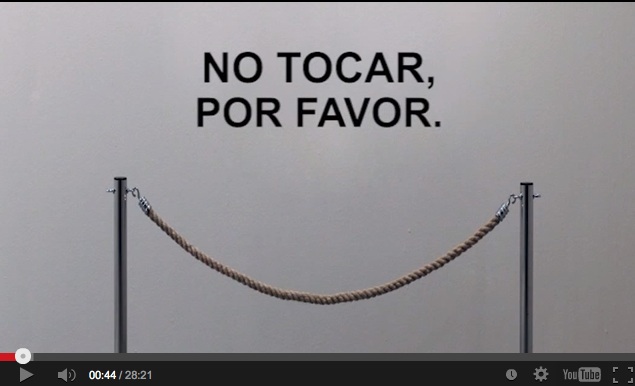Una noticia de Allison Meier en Hyperallergic al hilo de una entrada anterior sobre animales pintores:
Speedy the three-banded armadillo
Sure, humans tend to be the most dexterous of the animals, with their fancy thumbs and articulated motor skills, but can any people artists be as adorable as Speedy the three-banded armadillo? Unlikely. The South American mammal, whose defining skill is curling into a ball, is one of the many creatures creating art at the Oklahoma City Zoo as part of their “Art Gone Wild” program that uses painting as an avenue of animal engagement. While there are a lion’s share of painting elephants, apes, and rhinos garnering the occasional media attention, this zoo involves a level of biodiversity not seen elsewhere, with anaconda, wild dog, archer fish, red river hog, Komodo dragon, and okapi among the “artists.” The abstract color field results can be mixed (these are, after all, beings with an entirely different visual aesthetic from us), but when I recently talked over the phone with Tara Henson and Candice Rennels, director and manager respectively of marketing & public relations at the zoo, they emphasized the mutual benefit painting offers to the trainers and animals.
“There’s no tricks, everything has a purpose,” Rennels said. For example, many of the painting actions correspond to those that aid the trainers in medical procedure or physical exams, like an ape offering his arm for an immunization could also reach out to a canvas with the same gesture, or an elephant blowing air through its trunk into a bag for a test can create “an awesome mist” effect in an art session. They also encourage a trusting relationship between the trainers and animals. All of the paint is nontoxic, of course, so the animals can slither through or submerge their paws in the colors without risk to their health. (For Speedy, being of a species of armadillo that swims, he has a tub at one end of his painting area to clean off after his time in his “studio,” which is basically a long box stacked with canvases globbed with paint in which food is hidden for him to forage through.)
Zeppy, a Salmon Crusted Cockatoo, demonstrating his brush strokes
As for how much the animal is actually involved in selecting colors or creating forms, Rennels explained that “some have a higher level of thought process.” Sea lions, for instance, are color blind, so it’s the trainer dictating colors, but an elephant might favor orange paint if it is a fan of cantaloupes, associating the color with its favorite food. Their physical techniques always vary wildly, with snakes slithering through paint, leaving scale prints that would make ophiophobics shiver, and seals printing with their flippers in heavy swipes. Apes can actually pick up brushes; chimps tend to go for finger-painting.
What the animals most get out of it is a departure from their normal routine, a mentally stimulating activity involving their natural behaviors that staves off boredom. Rennels said that for animals like snakes “it’s more of a senses experience, with the texture and temperature of the paint.” They also receive some sort of reward (usually a treat) when performing whatever action they use in their art. Hands down the most amazing painting processes and result is with the archer fish, which can shoot water out of its mouth to catch an insect in the wild. At the zoo, a keeper patiently dangles a cricket on fishing line in front of a canvas layered with paint, until the archer fish finally spits a stream of water, causing the cricket to fall into its tank and splashing the paint in an unexpected pattern. ”People are astonished that that artwork was created basically by a fish,” Rennels said.
The art from the “animal enrichment” program is presented in an annual exhibition at a local art gallery, although it’s also available for sale online year-round. While absolutely no one will mistake the Komodo dragon’s painting for a piece by a tipsy Franz Kline, or the meerkat’s masterpiece for an extraordinarily lazy de Kooning, all the money raised by the sale of these experiments goes to support the zoo and conservation (this past year half was directed to the Okapi Wildlife Reserve in the Democratic Republic of Congo that was victimized in a violent attack). The Oklahoma City Zoo is now in its tenth year of the enrichment program, and the fourth year of hosting an exhibition, and is continuing to talk to other zoos and vets for more ideas of how to involve their animals. “This is first and foremost about the animals,” Rennels said. “We want to share with people the level of care we have for them.”
Speedy painting
Speedy’s painting “An Armadillo of One”
“Deadliest Catch” painted by an anaconda
Woma python in a painting session
Milk Snake creating some paintings
También podéis encontrar otros casos de animales que pintan para fines benéficos o por «iniciativa propia» aquí.


















